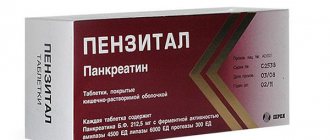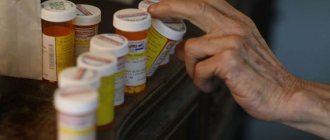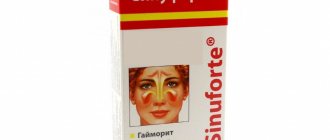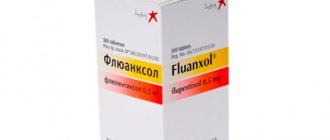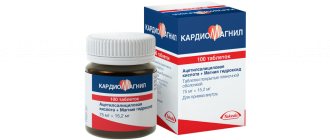Pharmacological properties of the drug Zidovudine
An antiviral agent that exhibits high activity against retroviruses, including HIV. Once inside the cell, zidovudine undergoes phosphorylation to triphosphate under the action of cellular kinases. Zidovudine triphosphate acts as an inhibitor and at the same time as a substrate for viral reverse transcriptase, while further formation of viral DNA is blocked due to the introduction of zidovudine triphosphate into the corresponding chains of its molecule. The competitive interaction of zidovudine triphosphate with HIV reverse transcriptase is approximately 100 times stronger than with human α-polymerase.
Side effects of the drug Zidovudine
Possible anemia, neutropenia and leukopenia, nausea, vomiting, anorexia, headache, skin rash, fever, myalgia, paresthesia, insomnia, a feeling of general discomfort, asthenia and dyspepsia, drowsiness, diarrhea, dizziness, increased sweating, shortness of breath, flatulence, perversion of taste , pain in the chest and abdomen, decreased mental activity, anxiety, increased urination, depression, generalized pain, chills, cough, hives, itching and a flu-like condition.
Side effects of HIV nucleoside reverse transcriptase inhibitors
With long-term use of HIV nucleoside reverse transcriptase inhibitors (NRTIs), they are characterized by various manifestations of toxicity [1-3].
Despite the large differences in clinical signs, lipodystrophy, lactic acidosis, hepatic steatosis and probably myopathy are due to the same underlying cause: mitochondrial (including peroxisomal) toxicity [4].
Mitochondrial toxicity, to one degree or another, is inherent in all NRTIs, but for each of the drugs it has a different nature and, therefore, tissue specificity, and also differs greatly in the rate of development and degree of toxicity.
Several main mechanisms of mitochondrial toxicity can be identified [5]:
- direct inhibition of mitochondrial DNA polymerase;
- influence on the Krebs cycle and β-oxidation of fatty acids;
- influence on the efficiency of carnitine-dependent transport of fatty acids across the mitochondrial membrane;
- possible influence on AMP-activated protein kinase, which controls the energy balance of the cell.
Currently, direct inhibition of mitochondrial DNA polymerase has been studied in detail. It is characteristic of zalcitabine , didanosine , stavudine and, to a much lesser extent, lamivudine . These drugs, or rather their triphosphorylated forms, terminate the synthesis of mitochondrial DNA and inhibit excision repair of defects that arise in its structure [6-9]. As a result, the number of mitochondria in cells decreases, while the DNA mutates, deletions and large insertions almost completely disrupt the expression of mitochondrial genes. Therapy for 6-12 months leads to acidosis in almost 70% of patients (zalcitabine, didanosine); after 18-24 months, lipodystrophy develops in almost 50% of cases (stavudine) [10-12]. The toxic effect caused by this process is independent of the tissue and can only be eliminated by drug withdrawal. Restoration of normally functioning mitochondria takes months and years [10,13]. Apparently, this is why the proportion of patients treated with zalcitabine , didanosine and stavudine is constantly decreasing.
Zidovudine, abacavir and tenofovir practically do not cause either suppression of mitochondrial DNA synthesis or suppression of the repair function of mitochondrial DNA polymerase, however, they can be involved in other mechanisms of mitochondrial activity [14,15].
The use of tenofovir causes the following complications, which may be associated with mitochondrial dysfunction:
- Fatty liver , ultimately – steatosis . The developers of tenofovir do not recommend its use in patients with fatty liver disease, noting fatal outcomes when used as part of antiretroviral therapy [16].
- Mitochondria in the liver and adipocytes begin to actively process sugars and synthesize fatty acids, which leads to lactic acidosis . The developers of tenofovir also do not recommend its use in cases of lactic acidosis [16].
Abacavir , like tenofovir, is an analog of purine nucleosides, which is probably why it is characterized by similar manifestations of mitochondrial toxicity [17].
zidovudine therapy causes complications, some of which are of the opposite nature:
- There is an inhibition of brown fat cells located in muscle tissue and adipocytes in the subcutaneous layer, which leads, in contrast to the effect of tenofovir, to lipodystrophy . However, fat accumulates in the visceral organs and the nape of the neck, and a “bull’s hump” is formed [18].
- As fatty acid reserves in muscle tissue and the subcutaneous layer are depleted, a switch occurs to mitochondria consuming sugars in muscle cells, which leads to myopathy and, in acute form, lactic acidosis [18].
The molecular mechanisms underlying the stimulation of obesity with the use of purine derivatives and, conversely, lipodystrophy with therapy with thymidine analogues can ultimately be reduced to the inhibition or activation of the Krebs cycle and β-oxidation of fatty acids - the main mechanisms leading to the synthesis of ATP (see Appendix ).
Thus, it can be stated that abacavir, zidovudine and tenofovir , unlike other NRTIs, have virtually no inhibitory effect on mitochondrial DNA polymerase, however, they are involved in various mechanisms of mitochondrial activity, more precisely in the processes of fatty acid metabolism, which leads to distortion of these mechanisms , and ultimately to toxic effects. In addition to mitochondrial toxicity, other toxic effects occur.
Thus, the use of abacavir causes hypersensitivity (up to 10% of cases), which usually manifests itself in the form of fever (fever), rash, gastrointestinal disorders (nausea, vomiting, diarrhea or abdominal pain), general malaise, including fatigue, and respiratory manifestations (pharyngitis, shortness of breath, cough, etc.). In some cases, hypersensitivity is fatal. In addition, the development of lymphopenia is observed. Patients who are carriers of the histocompatibility gene variant HLA-B*5701 are not recommended to use abacavir. Abacavir is also not recommended for children under 3 months of age [17].
Tenofovir promotes the removal of calcium from bone tissue, which leads to osteoporosis. Calcium-related osteopenia and pre- and postnatal toxicities have also been associated with tenofovir use. Apparently, therefore, it is not indicated for persons under 18 years of age (FDA), and pregnant women can be prescribed only in cases of extreme necessity [16]. The main side effect of tenofovir therapy is nephrotoxicity, which is associated with irreversible changes in the cells of the proximal renal tubules [19].
Zidovudine by inhibition of hematopoiesis, which is primarily manifested in the development of anemia and neutropenia [20]. It should be noted here that the use of phosphazide , which is a long-acting prodrug of zidovudine, can significantly reduce the development of anemia and other manifestations of hemotoxicity [21,22].
In general phosphazide is a less toxic drug than zidovudine [22,23]. Moreover, it is indicated for patients who have developed intolerance to zidovudine [24]. It is recommended for pregnant women and children, as well as for patients with liver disease [25-27]. There is evidence of successful treatment of combined infections (HIV + hepatitis C, HIV + tuberculosis) using phosphazide [28-30]. Finally, a significantly lower (several times) maximum concentration of azidothymidine in blood plasma when taking phosphazide compared to zidovudine can reduce the manifestations of mitochondrial toxicity [1] [31]. This may be why therapy using phosphazide, as a rule, is not accompanied by side effects characteristic of other antiretroviral drugs: vomiting, headaches, diarrhea, myalgia, anemia, thrombocytopenia and neutropenia [31].
Thus, abacavir, zidovudine, tenofovir and phosphazide have different toxic effects, which makes it possible to recommend their use for different groups of patients (see Table 1 and Table 2).
Tenofovir appears to selectively inhibit the hepatic form of AMPK [2], which leads to suppression of β-oxidation of fatty acids and increased cholesterol synthesis. In this case, mitochondria more intensively begin to process glucose and polysaccharides for the synthesis of ATP, which leads to obesity, including fatty liver (steatosis), as well as lactic acidosis. It is likely that tenofovir may also have an inhibitory effect on the Krebs cycle and β-oxidation of fatty acids, acting as a competitive inhibitor in a variety of enzymatic processes involving ADP, ATP and NAD. The exact mechanism of these processes is not known, but their result is the accumulation of fat throughout the body.
Zidovudine, on the contrary, leads to activation of the Krebs cycle and β-oxidation of fatty acids in mitochondria. This is probably due to the formation of 2-methylmalonate and β-aminoisobutyric acid (BAIBA), products of intracellular thymine processing. BAIBA [4-7] activates the expression of the hepatic isomer of carnitine palmitoyl transferase I (CPT I) [8], which leads to increased carnitine-dependent fatty acid transport in liver cells (hepatocytes) and white adipocyte cells, but not in muscle cells .
Malonate (derived from uracil by the same enzymes as methyl malonate from thymine) is an active inhibitor of the Krebs cycle, respiratory β-oxidation of fatty acids (inhibiting the activity of succinate dehydrogenase in both processes) and, in the form of malonyl-CoA, a participant in the initial and final stages of the β-oxidation cycle fatty acids [9]. The role of methyl malonate in this process apparently boils down to competition with malonate, which leads to activation of the Krebs cycle. At the same time, the efficiency of β-oxidation in muscle cells increases until fat reserves in brown and subcutaneous adipocytes are completely exhausted, which leads to a switch to the consumption of sugars with the occurrence of myalgia, myopathy and lactic acidosis [3]. Unlike abacavir and tenofovir, zidovudine does not cause fat accumulation in muscle tissue, much less in the liver, where fatty acid consumption is greatly increased due to the stimulation of CPT I under the influence of BAIBA.
| Literature: 1. Winder WW, Hardie DG // AMP-activated protein kinase, a metabolic master switch: possible roles in type 2 diabetes // Am. J. Physiol., 1999, v. 277(1), E1-E10. 2. Thomson DM, Porter BB, Tall JH, et al. // Skeletal muscle and heart LKB1 deficiency causes decreased voluntary running and reduced muscle mitochondrial marker enzyme expression in mice // Am. J. Physiol. Endocrinol. Metab., 2007, v. 292(1), E196-E202. 3. Kanazawa I., Yamaguchi T., Yano S., et al. // Activation of AMP kinase and inhibition of Rho kinase induce the mineralization of osteoblastic MC3T3-E1 cells through endothelial NOS and BMP-2 expression // Am. J. Physiol. Endocrinol. Metab., 2009, v. 296(1), E139-E146. 4. Begriche K., Massart J., Abbey-Toby A., et al. // β-Aminoisobutyric acid prevents diet-induced obesity in mice with partial leptin deficiency // Obesity, 2008, v. 16(9) p. 2053-2067. 5. Zhu Z., Hitchcock MJ, Sommadossi JP // Metabolism and DNA interaction of 2′,3′-didehydro-2′,3′-dideoxythymidine in human bone marrow cells // Mol. Pharmacol., 1991, v. 40(5), p. 838-845. 6. Kaul S, Dandekar KA, Schilling BE, et al. // Toxicokinetics of 2′,3′-didehydro-3′-deoxythymidine, stavudine (D4T) // Drug Metab. Dispos., 1999, v. 27(1), p. 1-12. 7. Maisonneuve C., Igoudjil A., Begriche K., et al. // Effects of zidovudine, stavudine and beta-aminoisobutyric acid on lipid homeostasis in mice: possible role in human fat wasting // Antivir. Ther., 2004, v. 9(5), p. 801-810. | 8. Note R., Maisonneuve C., Lettéron P., et al. // Mitochondrial and metabolic effects of nucleoside reverse transcriptase inhibitors (NRTIs) in mice receiving one of five single- and three dual-NRTI treatments // Antimicrob. Agents Chemother., 2003, v. 47(11), p. 3384-3392. 9. Dervartanian DV, Veeger C. // Studies on succinate dehydrogenase. I. Spectral properties of the purified enzyme and formation of enzyme-competitive inhibitor complexes // Biochim. Biophys. Acta, 1964, v. 92, p. 233-247. 10. Zhou G., Myers R., Li Y., et al. // Role of AMP-activated protein kinase in the mechanism of metformin action // J. Clin. Invest., 2001, v. 108(8), p. 1167-1174. 11. Sommadossi JP, Carlisle R, Schinazi RF, et al. // Uridine reverses the toxicity of 3′-azido-3′-deoxythymidine in normal human granulocyte-macrophage progenitor cells in vitro without impairment of antiretroviral activity // Antimicrob. Agents Chemother., 1988, v. 32(7), p. 997-1001. 12. Koch EC, Schneider J, Weiss R, et al. // Uridine excess does not interfere with the antiretroviral efficacy of nucleoside analogue reverse transcriptase inhibitors // Antivir. Ther., 2003, v. 8(5), p. 485-487. 13. McComsey GA, O'Riordan M, Setzer B, et al. // Uridine supplementation in HIV lipoatrophy: pilot trial on safety and effect on mitochondrial indices // Eur. J. Clin. Nutr., 2008, v. 62(8), p. 1031-1037. |
Table 1
| No. | Groups of HIV-infected people | Abacavir** | Zidovudine | Tenofovir | Phosphazide |
| 1 | Adult patients with fatty liver | not recommended | can be used | not recommended | preferred |
| 2 | Adult patients with signs of hematopoietic suppression (anemia, neutropenia) | can be used | not recommended | shown | can be used |
| 3 | Adult patients with renal failure (Fanconi syndrome) | can be used | can be used | not recommended | preferred |
| 4 | Adult patients with reduced bone density | can be used | can be used | not recommended | preferred |
| 5 | Adult patients with myalgia | can be used | not recommended | shown | no data |
| 6 | Adult patients with viral hepatitis (HBV, CHC) | can be used (with caution) | not recommended (cannot be used with ribavirin) | can be used (with caution) | preferred (can be used with ribavirin) |
| 7 | Adult patients with tuberculosis | can be used | can be used | can be used | preferred |
| 8 | Pregnant women | can be used (with caution) | can be used | not recommended | preferred |
| 9 | Persons under 18 years of age | not recommended for children under 3 months | can be used | not recommended | preferred |
| 10 | Adult patients with central nervous system damage | can be used | can be used | no data | preferred (in late stages of HIV, in the absence of anemia |
______________________
*Recommendations are based on NRTIs that cause little or no direct inhibition of mitochondrial DNA polymerase.
**Before prescribing abacavir-containing therapy, patients must be analyzed for the presence of the histocompatibility gene variant HLA-B*5701. In cases of a positive result, the use of abacavir is unacceptable.
table 2
| ARV drug | Typical side effects | Proposed replacement |
| Abacavir** | Hypersensitivity reaction. Lymphopenia. Fatty liver and lactic acidosis. | Phosphazide is most preferred, tenofovir or zidovudine may be used |
| Zidovudine | Depression of hematopoiesis (anemia, neutropenia). Development of lipodystrophy of the liver, muscle tissue, myopathy and lactic acidosis. Gastrointestinal intolerance, headache, insomnia, asthenia. Dyschromia of skin and nails. | Tenofovir or phosphazide are most preferable (depending on the general condition of the patient: for kidney dysfunction, reduced bone density, fatty liver, for persons under 18 years of age and pregnant women, phosphazide should be used) |
| Tenofovir | Renal failure, Fanconi syndrome. Asthenia, headache, diarrhea, nausea, vomiting, flatulence. Decreased bone density, osteomalacia. Fatty liver and lactic acidosis. | Phosphazide is most preferable; zidovudine may be used; in rare cases, switching to abacavir is justified. |
| Phosphazide | Nausea. Slight inhibition of hematopoiesis (anemia, neutropenia) | Tenofovir or abacavir (depending on the patient's general condition) |
______________________
*Recommendations are based on NRTIs that cause little or no direct inhibition of mitochondrial DNA polymerase.
**Before prescribing abacavir-containing therapy, patients must be analyzed for the presence of the histocompatibility gene variant HLA-B*5701. In cases of a positive result, the use of abacavir is unacceptable.
1. Dieterich DT // Long-term complications of nucleoside reverse transcriptase inhibitor therapy // AIDS Read., 2003, v. 13(4), p. 176-184, 187.
2. Brinkman K., Smeitink JA, Romijn JA, et al. // Mitochondrial toxicity induced by nucleoside-analogue reverse-transcriptase inhibitors is a key factor in the pathogenesis of antiretroviral-therapy-related lipodystrophy // Lancet, 1999, v. 354(9184), p. 1112-1115.
3.Troll JG // Approach to dyslipidemia, lipodystrophy, and cardiovascular risk in patients with HIV infection // Curr. Atheroscler. Rep., 2011, v. 13(1), p. 51-56.
4. Mallon, P. W., Unemori P., Sedwell R., et al. // In vivo, nucleoside reverse-transcriptase inhibitors alter expression of both mitochondrial and lipid metabolism genes in the absence of depletion of mitochondrial DNA // J. Infect. Dis., 2005, v. 191(10), p. 1686-1696.
5. Viengchareun S., Caron M., Auclair M., et al. // Mitochondrial toxicity of indinavir, stavudine and zidovudine involves multiple cellular targets in white and brown adipocytes // Antivir. Ther., 2007, v. 12(6), p. 919-929.
6. Levis W. // Pharmacogenomics, toxicogenomics, and DNA polymerase gamma // J. Infect. Dis., 2007, v. 195(10), p. 1399-1401.
7. Lim SE, Copeland WC // Differential incorporation and removal of antiviral deoxynucleotides by human DNA polymerase gamma // J. Biol. Chem., 2001, v. 276(26), p. 23616-23623.
8. Johnson AA, Ray AS, Hanes J., et al. // Toxicity of antiviral nucleoside analogs and the human mitochondrial DNA polymerase // J. Biol. Chem., 2001, v. 276(44), p. 40847-40857.
9. Moyle G. // Mitochondrial toxicity: myths and facts // J. HIV Ther., 2004, v. 9(2) p. 45-47.
10. McComsey GA, Paulsen DM, Lonergan JT, et al. // Improvements in lipoatrophy, mitochondrial DNA levels and fat apoptosis after replacing stavudine with abacavir or zidovudine // AIDS, 2005, v. 19(1), p. 15-23.
11. van Vonderen MG, van Agtmael MA, Hassink EA, et al. // Zidovudine/lamivudine for HIV-1 infection contributes to limb fat loss // PLoS One, 2009, v. 4(5), e5647.
12. Kaul S, Dandekar KA, Schilling BE, et al. // Toxicokinetics of 2′,3′-didehydro-3′-deoxythymidine, stavudine (D4T) // Drug Metab. Dispos., 1999, v. 27(1), p. 1-12.
13. Martin A., Smith DE, Carr A., et al. // Reversibility of lipoatrophy in HIV-infected patients 2 years after switching from a thymidine analogue to abacavir: the MITOX Extension Study // AIDS, 2004, v. 18(7), p. 1029-1036.
14. Lund KC, Wallace KB // Direct, DNA pol-gamma-independent effects of nucleoside reverse transcriptase inhibitors on mitochondrial bioenergetics // Cardiovasc. Toxicol., 2004, v. 4(3), p. 217-228.
15. Note R., Maisonneuve C., Lettéron P., et al. // Mitochondrial and metabolic effects of nucleoside reverse transcriptase inhibitors (NRTIs) in mice receiving one of five single- and three dual-NRTI treatments // Antimicrob. Agents Chemother., 2003, v. 47(11), p. 3384-3392.
16. https://www.gilead.com/pdf/viread_pi.pdf
17. https://us.gsk.com/products/assets/us_ziagen.pdf
18. https://us.gsk.com/products/assets/us_retrovir.pdf
19. Rodríguez-Nóvoa S., Labarga P., Soriano V., et al. // Predictors of kidney tubular dysfunction in HIV-infected patients treated with tenofovir: a pharmacogenetic study // Clin. Infect. Dis., 2009, v. 48(11), e108-e116.
20. Kakuda TN // Pharmacology of nucleoside and nucleotide reverse transcriptase inhibitor-induced mitochondrial toxicity // Clin. Ther., 2000, v. 22(6), p. 685-708.
21. Ivanova E., Vorobeva N. // Efficacy and safety of hematological of phosphazide of highly active antiretroviral therapy for HIV-infected patients: 48 weeks of treatment // Program abstracts Euromedica, Hannover, 2011, p. 68-69.
22. Kravchenko A.V. // Use of Nikavir as part of antiretroviral therapy // Medical Department, 2004, No. 2(10), p. 90-92, 166-172.
23. Galegov G.A. // Nikavir (phosphazide) - an antiretroviral drug: anti-HIV activity, toxicology, pharmacokinetics and some prospects for clinical use // Antibiotics and Chemotherapy, 2004, v. 49(7), p. 3-8.
24. Yurin O., Kravtchenko A., Afonina L., et al. // Treatment of the patients with intolerance to AZT by phosphazid // 5 International Congress on drug therapy in HIV-infection, Glasgow, UK, 2000, v. 14, Suppl. 4, Abstr. P13.
25. Ivanova E.S., Shmagel N.G., Vorobyova N.N. // Nikavir in schemes for chemoprophylaxis of vertical transmission of HIV infection // Questions of Virology, 2010, v. 55(2), p. 31-34.
26. Ivanova E.S., Vorobyova N.N. // Nikavir in perinatal chemoprophylaxis // Materials of the IV (XIII) International Scientific Conference “Oncology - XXI Century”, Ho Chi Minh City, Vietnam, 2009, p. 88-91.
27. Kravchenko AV, Gankina NY // Efficiency and safety of phosphazide in circuit oh HAART in HIV-infected treatment-naïve patient // 8 International Congress on drug therapy in HIV-infection, Glasgow, UK, 2006, Abstr. P395.
28. Gankina N.Yu., Kravchenko A.V., Kuimova U.A., et al. // Nucleoside inhibitors in antiretroviral therapy regimens for co-infection of HIV and chronic hepatitis C // Infectious Diseases, 2010, v. 8( 1), p. 14-18.
29. Kuimova U.A., Kravchenko A.V., Gankina N.Yu. and others // Frequency of hematological disorders in the treatment of chronic hepatitis C in patients with HIV infection receiving ART // Collection of abstracts of the III Conference on HIV/AIDS in Eastern Europe and Central Asia, Moscow, 2009, vol. 1, p. 24-25.
30. Panteleev A.M., Goliusova M.Yu., Kabanova V.I. // Results of the use of phosphazide (Nikavir) in patients with HIV infection and tuberculosis // HIV infection and immunosuppression, 2010, v. 2(2), p. 75-79.
31. Khandazhinskaya A., Matyugina E., Shirokova E. // Anti-HIV therapy with AZT prodrugs: AZT phosphonate derivatives, current state and prospects // Expert Opin. Drug Metab. Toxicol., 2010, v. 6(6), p. 701-714.
[1] Despite more than ten years of use of phosphazide in clinical practice, there is no data on the development of lipodystrophy, myopathy and lactic acidosis with its use.
[2] It is known that metformin (an antidiabetic drug) activates AMPK, reduces blood glucose concentrations by inhibiting glucose production (gluconeogenesis) in the liver and increases fatty acid oxidation [10], which indirectly confirms the inhibition of AMPK by tenofovir.
[3] These side effects that occur with zidovudine therapy can be compensated for by regular use of uracil [11-13].
Special instructions for the use of the drug Zidovudine
If the patient's hemoglobin level is reduced to 75–90 g/l or the number of neutrophil granulocytes is reduced to 0.75–1•109/l, the daily dose of zidovudine must be reduced by 2 times (with an interval between doses every 8 hours). Normalization of these indicators accelerates with a short break in treatment. After normalization of these indicators, the dose can be increased to the original values. Treatment with zidovudine should be discontinued if the hemoglobin level is below 75 g/l or the neutrophil granulocyte count is 0.75 x 109/l. When treating elderly patients, there is a high risk of renal failure. In patients with liver cirrhosis, zidovudine accumulates due to decreased glucuronidase activity. Treatment with zidovudine does not reduce the risk of HIV infection in persons who are in contact with an infected person.
Zidovudine
Treatment with Zidovudine should be carried out by a physician experienced in treating HIV-infected patients.
Patients should be warned that zidovudine has not been shown to prevent the risk of transmitting HIV to others through sexual contact or exposure to infected blood, and patients should continue to take appropriate precautions.
Zidovudine does not cure HIV infection, and patients remain at risk of developing opportunistic infections and malignancies due to immunosuppression. Although the drug Zidovudine reduces the risk of developing opportunistic infections, data on the risk of developing neoplasms, including lymphomas, with the use of the drug are limited.
Available data from patients treated for advanced HIV infection indicate that the risk of developing lymphoma is similar to that of untreated patients. In patients with early stage HIV infection who are receiving long-term treatment, the risk of developing lymphoma is unknown.
Pregnant women considering the use of zidovudine during pregnancy to prevent transmission of HIV to their children should be advised that in some cases transmission may occur even despite treatment.
Emergency prevention in case of possible infection.
According to international recommendations, in case of probable contact with HIV-infected material (blood, other liquids), it is necessary to urgently prescribe combination therapy with zidovudine and lamivudine within T-2 hours from the moment of infection. In case of a high risk of infection, a drug from the group of HIV protease inhibitors (HIV PIs) should be included in the treatment regimen.
Prophylactic treatment is recommended for 4 weeks. Despite the rapid initiation of treatment with antiretroviral drugs, the development of seroconversion cannot be ruled out.
Adverse reactions from the hematopoietic system
Anemia (usually observed 6 weeks after starting Zidovudine, but sometimes may occur earlier), neutropenia (usually occurs 4 weeks after starting Zidovudine, but sometimes occurs earlier), leukopenia (usually secondary to neutropenia) may occur in patients with an advanced clinical picture of HIV infection receiving Zidovudine, especially in high doses (1200-1500 mg/day), and having reduced bone marrow hematopoiesis before treatment, especially at the late stage of HIV infection.
While taking Zidovudine in patients with an advanced clinical picture of HIV infection, it is necessary to monitor hematological parameters at least once every 2 weeks during the first 3 months of therapy, and then monthly. In the early stages of HIV infection (with undepleted reserves of bone marrow hematopoiesis), undesirable reactions from the hematopoietic system rarely develop, so general blood tests may be performed less frequently, depending on the general condition of the patient (for example, once every 1-3 months).
If the hemoglobin content decreases to 75-90 g/l (4.65-5.59 mmol/l), or the number of neutrophils decreases to 0.75-1.0 x 109/l, the daily dose of zidovudine should be reduced until recovery blood counts or the drug Zidovudine is discontinued for 2-4 weeks until blood counts are restored. Usually the blood picture normalizes after 2 weeks, after which the drug Zidovudine in a reduced dose can be re-prescribed. Despite reducing the dose of Zidovudine, severe anemia may require blood transfusions.
Lactic acidosis and severe hepatomegaly with steatosis
These complications can be fatal both with monotherapy with Zidovudine and with the use of Zidovudine as part of combination therapy. The risk of developing these complications increases in women. Clinical signs of these complications may include gastrointestinal symptoms (nausea, vomiting and abdominal pain), general weakness, anorexia, lack of appetite, rapid unexplained weight loss, respiratory symptoms (shortness of breath and tachypnea) or neurological symptoms (including motor weakness). The use of nucleoside analogs should be discontinued if symptomatic hyperlactatemia and metabolic acidosis/lactic acidosis, progressive hepatomegaly, or a rapid increase in aminotransferase activities occur.
Caution should be exercised when prescribing the drug to patients (especially overweight women) with hepatomegaly, hepatitis or other known risk factors for liver damage and hepatic steatosis (including the use of certain medications and alcohol consumption). Patients coinfected with hepatitis C and patients receiving treatment with interferon alfa and ribavirin may be at particular risk. Patients at increased risk require special attention. Zidovudine should be discontinued in all cases of clinical or laboratory signs of lactic acidosis with or without hepatitis, which may include hepatomegaly with steatosis, even in the absence of increased transaminase activity.
Redistribution of subcutaneous fat tissue
Redistribution and/or accumulation of subcutaneous fat, including central obesity, increased fat on the back of the neck (“buffalo hump”), decreased subcutaneous fat on the face and extremities, enlarged mammary glands, increased serum lipids and blood glucose was noted both in combination and separately in some patients receiving combination antiretroviral therapy.
To date, all drugs in the HIV protease inhibitor (PI) and nucleoside reverse transcriptase inhibitor (NRTI) classes have been associated with one or more specific adverse events associated with a common syndrome often called lipodystrophy. However, clinical data indicate that there are differences in the risk of developing this syndrome between specific representatives of therapeutic classes.
In addition, lipodystrophy syndrome has a multifactorial etiology, with factors such as stage of HIV infection, advanced age, and duration of antiretroviral therapy playing an important, possibly synergistic role.
The long-term consequences of this phenomenon are currently unknown. Clinical evaluation should include physical examination to assess for the presence of subcutaneous fat redistribution. A study of serum lipid and blood glucose concentrations should be recommended. Lipid disorders should be treated as clinically indicated.
Immune reconstitution syndrome
In HIV-infected patients with severe immunodeficiency, during the initiation of antiretroviral therapy, an exacerbation of the inflammatory process against the background of asymptomatic or residual opportunistic infection is possible, which can cause serious deterioration of the condition or aggravation of symptoms. Typically, such reactions have been described in the first weeks or months of starting antiretroviral therapy. The most significant examples are cytomegalovirus retinitis, a generalized and/or focal mycobacterial infection, and pneumonia caused by Pneumocystis
jiroveci (P. carinii ).
Any symptoms of inflammation must be immediately identified and treatment initiated if necessary.
Autoimmune diseases (such as Graves' disease, polymyositis and Guillain-Barre syndrome) have been observed in the setting of immune reconstitution, but the timing of initial manifestations varies and the disease may occur many months after the start of therapy and have an atypical course.
Coinfection with HIV and viral hepatitis C
An increase in ribavirin-induced anemia has been reported in HIV-infected patients receiving concomitant zidovudine therapy, but the exact mechanism of this phenomenon is unknown. Therefore, the combined use of ribavirin and zidovudine is not recommended. The antiretroviral regimen should be changed to a regimen that does not contain zidovudine, especially in patients with a history of zidovudine-induced anemia.
Liver failure (sometimes fatal) has occurred in patients infected with HIV and hepatitis C virus who received combination antiretroviral therapy for HIV and interferon alfa with or without ribavirin.
Patients receiving interferon alfa with or without ribavirin and zidovudine should be monitored for treatment-related toxicities, particularly the development of liver failure, neutropenia, and anemia. In such cases, discontinuation of use of the drug Zidovudine should be considered. Dose reduction or discontinuation of interferon alfa, ribavirin, or both should also be considered if clinical toxicity increases, including development of liver failure (eg, Child-Pugh score greater than 6) (see prescribing information for interferon alfa and ribavirin) .
Myopathy and myositis
Myopathy and myositis with pathological changes characteristic of the course of HIV infection have been associated with long-term use of zidovudine.
Combined use with zidovudine-containing drugs
The drug Zidovudine should not be used in conjunction with drugs containing zidovudine as one of the components.
Drug interactions Zidovudine
With simultaneous use of zidovudine, the level of diphenine in the blood decreases. Taking paracetamol during treatment with zidovudine increases the incidence of neutropenia, especially after long-term treatment. Acetylsalicylic acid, codeine, morphine, indomethacin, ketoprofen, oxazepam, lorazepam, cimetidine, clofibrate can also slow down the metabolism of zidovudine. Concomitant treatment with drugs that have nephrotoxic effects or suppress hematopoiesis may increase the risk of toxic effects of zidovudine. Some nucleoside analogues (eg ribavirin) in vitro , so their simultaneous administration should be avoided. Probenecid may prolong the half-life of zidovudine.
List of pharmacies where you can buy Zidovudine:
- Moscow
- Saint Petersburg



